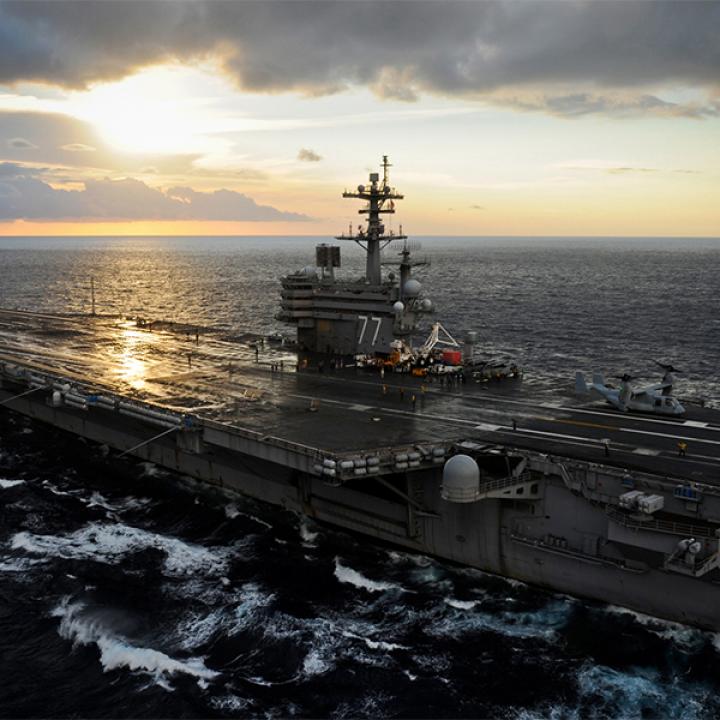
- Policy Analysis
- Articles & Op-Eds
Getting Carrier Out of the Gulf Good for U.S. Iran Policy
Also published in Defense News

Other moves would do more than a carrier presence could to push Tehran toward a diplomatic solution.
Unlikely as it may seem, one of the possible unintended benefits of sequestration may be the decision to cancel the departure of the aircraft carrier Harry S. Truman to the Arabian Gulf. The U.S. Navy has had a carrier in the gulf, on and off, for more than 20 years now, and it has maintained a nearly continuous presence there since 2010, while a second carrier in the Gulf of Oman supports operations in Afghanistan.
Conventional wisdom says the presence of an American aircraft carrier in the gulf deters Iranian adventurism or aggression. But consider the fact that a U.S. carrier has never once launched aircraft against Iran in anger, despite Tehran's role in the death of 19 U.S. airmen in the 1996 bombing of Khobar Towers in Saudi Arabia; its support for Shiite "special groups" that killed hundreds of U.S. service members in Iraq during the past decade; and Tehran's plotting to assassinate the Saudi ambassador in Washington in 2011.
Moreover, while Tehran would undoubtedly prefer that U.S. forces leave the region so that it might have a free hand to deal with its neighbors, the presence of a carrier in the gulf offered a silver lining for Iran: It enabled the Islamic Republic to hold a U.S. strategic asset at risk. (Senior Iranian military officials have said as much on several occasions.)
Any time a carrier operated in the gulf, it operated within range of a large number of highly capable Iranian anti-ship systems, including modern anti-ship cruise missiles, wake homing torpedoes and rising mines. In a conflict with Iran, there is a good chance that the carrier would have sustained some damage, enabling Iran to claim a propaganda victory, as the first country to bloody a U.S. carrier in combat since World War II.
Against this background, sailing aircraft carriers up and down Iran's coast accomplished very little, except to put U.S. service members and critical assets at risk.
The presence of a U.S. carrier in the gulf likewise heightened the potential for escalation if Israel or the U.S. launched preventive strikes against Iran's nuclear infrastructure. In the aftermath of such a strike, the carrier would have proved a tempting target and Iran might have been willing to risk escalation to strike a painful blow against the United States.
Without a carrier to target, Iran would have fewer ways to escalate "big" after a preventive strike. The absence of a carrier in the gulf would also reduce the likelihood that in the aftermath of an Israeli strike, Iran could retaliate in a way that inflicted significant losses on the U.S., thereby sparking a crisis in U.S.-Israel relations.
That said, the U.S. still needs to maintain a sizable naval presence in the gulf, it still needs to be ready to send a second aircraft carrier back to the region in event of a crisis, and it needs to significantly strengthen U.S. aerospace forces in the region. This would assure its wary Gulf Cooperation Council allies that the canceled deployment of the carrier does not signify reduced U.S. commitment to their security. It would counter possible Iranian efforts to take credit for the carrier's departure. And it would signal to Iran that the canceled deployment of the second carrier does not translate to a loss of capability.
In particular, the failure to offset the departure of the carrier with the strengthening of aerospace forces in the gulf could turn an act of military prudence, prompted by a desire to cut costs, into a major setback for America's standing in the region, by reinforcing the impression that the U.S. is abandoning its allies there.
The canceled deployment should also force a rethink of how to more effectively employ the military to support nuclear diplomacy with Iran.
Having repeatedly eschewed, for several decades now, the use of force in response to Iranian-sponsored terrorism, the U.S. suffers from a credibility deficit vis-a-vis Iran. Accordingly, repeated assertions by American officials that "all options are on the table" do not resonate powerfully in the Iranian capital.
What is needed is a long-term effort to alter Tehran's risk calculus and its perception of U.S. credibility and resolve. With Iran, subtlety and indirection work better than bluster and direct threats. Successful diplomacy also requires a credible offer to Tehran of a peaceful nuclear program that cannot serve as a path to "the bomb."
A good start would be an end to statements by senior U.S. officials that cast doubt on the efficacy of military action Iran's nuclear program; more assertive responses to Tehran's use of proxies and involvement in terrorism -- for instance, working with allies to "out" and expel Iranian intelligence agents operating abroad; and actions that demonstrate the U.S. is preparing for the possibility of a confrontation with Tehran, such as withdrawing dependents from select embassies and military facilities in the region.
Leaks to the media that highlight how the U.S. is preparing for the possibility of a conflict in the gulf also could be useful.
Such moves will do more than the presence of a carrier in the gulf did to convince Tehran that while Washington seeks to peacefully resolve the nuclear crisis with Iran, it is preparing in earnest for other outcomes -- and that the Islamic Republic should seize the possibility of a diplomatic solution while it can.
Michael Eisenstadt directs the Military and Security Studies Program at The Washington Institute.



